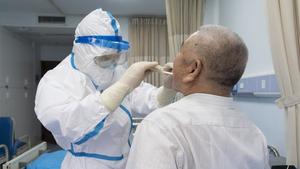 A medical worker (left) takes a swab sample at the Fourth People's Hospital of Sichuan in Chengdu, capital of southwest China's Sichuan province, May 8, 2020. (PHOTO / XINHUA)
A medical worker (left) takes a swab sample at the Fourth People's Hospital of Sichuan in Chengdu, capital of southwest China's Sichuan province, May 8, 2020. (PHOTO / XINHUA)
Intensified efforts will be made to upgrade medical and public health facilities across China so they are better positioned to cope with major public health emergencies, a senior official said on Tuesday.
The efforts are part of measures to strengthen the country's public health system in the wake of the COVID-19 epidemic, Ou Xiaoli, chief for social development at the National Development and Reform Commission, said at a news conference at the State Council Information Office.
We have made significant progress in the prevention and control of the epidemic, and the public health system that has been built after many years has played an important role in epidemic control. On the other hand, the epidemic has also exposed shortfalls in China's public health system.
Ou Xiaoli, Chief for social development, National Development and Reform Commission, China
"We have made significant progress in the prevention and control of the epidemic, and the public health system that has been built after many years has played an important role in epidemic control," he said. "On the other hand, the epidemic has also exposed shortfalls in China's public health system."
During the early stages of the COVID-19 outbreak in Wuhan, Hubei province, public health services failed to meet demand due to the explosive spread of the novel coronavirus, leading to a shortage in fever inpatient services, beds for patients and important medical equipment, Ou said.
To improve public health facilities across the country, the central government has doubled the budget for investment in related projects this year, he said.
ALSO READ: Reforms to boost performance of China's public health system
In addition, to improve the ability to diagnose infectious diseases, all secondary hospitals or above will optimize layouts of fever clinics, including increasing distances between patients waiting to see doctors, and be fully equipped for disease screening, he said.
Intensive care units in all hospitals should be equipped with negative-pressure wards and operating rooms, or be prepared so ordinary wards and operating rooms in ICU departments can be adapted to negative-pressure ones to rescue patients with infectious diseases if necessary. Meanwhile, ICUs should also be equipped with devices such as mechanical ventilators and cardiopulmonary resuscitation equipment if necessary, Ou said.
Moreover, to improve virus testing capacity for public health institutions and hospitals, authorities will build new P3 level high-grade labs across China that are capable of operations involving dangerous viruses that could transmit through respiration, such as the novel coronavirus. More P2 labs will also be built so every prefecture-level city in China will have at least one P2 lab, Ou said. Biological labs are divided into four grades, with P4 being the most secure.
READ MORE: Public health gets boost in war on virus
Further, authorities will also guide hospitals and clinics nationwide to build reserves of materials such as surgical masks, protective gowns and goggles so that the demand for such materials can be met during the initial period of any outbreak, Ou said.
Following the outbreak of the novel coronavirus, in an unprecedented move, the Chinese government mobilized the whole nation to contain the epidemic in Wuhan.
The epidemic has been under control in China since March, with the majority of confirmed cases contained in Wuhan.
The government has also provided free treatment for all COVID-19 patients. By July 19, China's healthcare insurance fund paid more than 1.2 billion yuan (US$171 million) to COVID-19 patients, said Xiong Xianjun, an official from the National Medical Products Administration. Medical costs that are not covered by healthcare insurance programs will be paid by local governments.
wangxiaodong@chinadaily.com.cn


